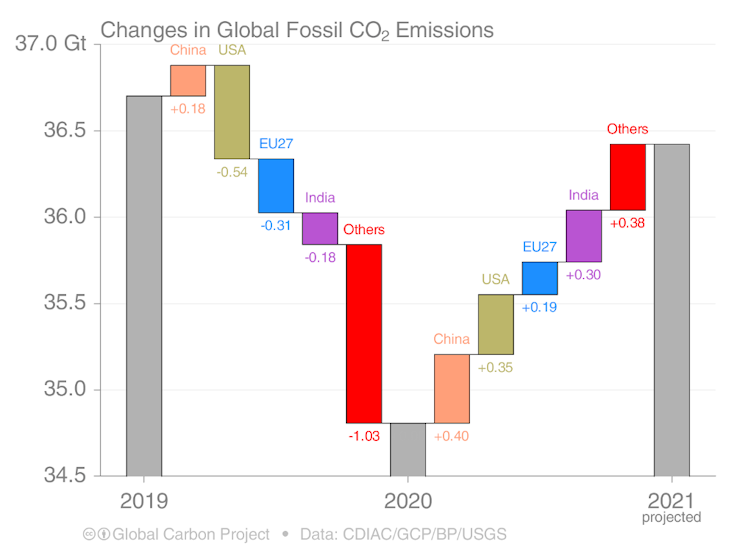Will the Co2 Concentration Drop Again
Climate Modify
Global emissions almost back to pre-pandemic levels after unprecedented driblet in 2020, new analysis shows
From the kickoff of 2022, the world tin emit an boosted 420 billion tonnes of CO2 to limit global warming to 1.v℃, or eleven years of emissions at this yr'due south rate
By Pep Canadell, Corinne Le Quéré, Glen Peters, Pierre Friedlingstein, Robbie Andrew, Rob Jackson
Published: Thursday 04 Nov 2021
Global carbon dioxide emissions have bounced back after COVID-19 restrictions and are probable to reach shut to pre-pandemic levels this yr, our analysis released today has found.
The troubling finding comes every bit the CoP26 climate talks keep in Glasgow in a terminal-ditch bid to proceed dangerous global warming at bay. The assay was undertaken by the Global Carbon Project, a consortium of scientists from effectually the world who produce, collect and analyse global greenhouse gas information.
The fast recovery in CO2 emissions, following final yr'south sharp drop, should come as no surprise. The earth's potent economic rebound has created a surge in demand for energy, and the global energy system is still heavily dependent on fossil fuels.
Almost concerning is the long-term upwards trends of CO2 emissions from oil and gas, and this year'south growth in coal emissions, which together are far from trending towards net-zero by 2050.

Global CO2 emissions from fossil fuels dropped by 5.4 per cent in 2020, compared to the previous year. Merely they are set to increase past nigh four.ix per cent above 2020 levels this year, reaching 36.4 billion tonnes. This brings them almost back to 2019 levels.
Nosotros tin can await another 2.9 billion tonnes of CO2 emissions this twelvemonth from the net result of everything nosotros practice to the state, including deforestation, degradation and re-vegetation.
This brings us to a total of 39.4 billion tonnes of CO2 to exist emitted by the terminate of this year.
The fast growth in emissions matches the corresponding big increment in energy demand every bit the global economic system opens up, with the help of $17.2 trillion in economic stimulus packages effectually the world.
CO2 emissions from all fossil fuel types (coal, oil and natural gas) grew this yr, with emissions from coal and natural gas set to grow more in 2021 than they vicious in 2020.
Emissions from global coal use were declining earlier the pandemic hitting in early 2020 only they surged back this year. Emissions from global gas utilise have returned to the rising tendency seen earlier the pandemic.
CO2 emissions from global oil use remain well below pre-pandemic levels merely are expected to increase in coming years as road transport and aviation recover from COVID-related restrictions.

Emissions from China have recovered faster than other countries. It's among the few countries where emissions grew in 2020 (by 1.4 per cent) followed by a projected growth of iv per cent this year.
Taking these two years together, CO2 emissions from China in 2021 are projected to be 5.v per cent above 2019 levels, reaching xi.1 billion tonnes. Cathay accounted for 31 per cent of global emissions in 2020.
Coal emissions in Mainland china are estimated to grow by ii.4 per cent this yr. If realised, information technology would match what was idea to be China's peak coal emissions in 2013.
Bharat's CO₂ emissions are projected to grow even faster than China's this year at 12.six per cent, after a 7.three per cent fall final year. Emissions this year are set to be 4.4 per cent above 2019 levels — reaching 2.7 billion tonnes. Republic of india deemed for seven per cent of global emissions in 2020.
Emissions from both the U.s. and European Union are projected to rise vii.half dozen per cent this year. Information technology would lead to emissions that are, respectively, 3.vii per cent and four.2 per cent below 2019 levels.
The states and Eu, respectively, accounted for 14 per cent and 7 per cent of global emissions in 2020.
Emissions in the residue of the globe (including all international transport, particularly aviation) are projected to rise ii.9 per cent this yr, merely remain 4.2 per cent below 2019 levels. Together, these countries represent 59 per cent of global emissions.

The relatively large changes in almanac emissions over the past 2 years accept had no discernible issue in the speed at which CO2 accumulates in the atmosphere.
CO2 concentrations, and associated global warming, are driven by the accumulation of greenhouse gases — particularly CO2 — since the get-go of the industrial era. This accumulation has accelerated in recent decades.
To cease farther global warming, global CO2 emissions must end or attain cyberspace-zero — the latter meaning that whatever remaining CO2 emissions would have to be compensated for past removing an equivalent corporeality from the atmosphere.
Carbon budgets are a useful way of measuring how much CO2 tin can be emitted for a given level of global warming. In our latest analysis, we updated the carbon upkeep outlined past the Intergovernmental Panel on Climate Change (IPCC) in August this year.
From the kickoff of 2022, the globe tin can emit an additional 420 billion tonnes of CO2 to limit global warming to 1.5℃, or xi years of emissions at this year's charge per unit.
To limit global warming to two℃, the world can emit an boosted i,270 billion tonnes of CO2 — or 32 years of emissions at the current rate.

These budgets are the compass to net-aught emissions. Consistent with the pledge by many countries to reach net-cipher emissions by 2050, CO2 emissions need to decline by ane.four billion tonnes each yr, on average.
This is an amount comparable to the drib during 2020, of 1.ix billion tonnes. This fact highlights the boggling challenge ahead and the need to increase brusque- and long-term commitments to bulldoze down global emissions.

This story is office of The Chat's coverage on COP26, the Glasgow climate conference, past experts from around the world.
Amid a ascension tide of climate news and stories, The Conversation is here to clear the air and brand certain y'all get data you tin can trust. More. ![]()
Pep Canadell, Chief research scientist, Climate Science Centre, CSIRO Oceans and Atmosphere; and Executive Director, Global Carbon Projection, CSIRO; Corinne Le Quéré, Purple Society Inquiry Professor of Climatic change Scientific discipline, University of East Anglia; Glen Peters, Inquiry Director, Center for International Climate and Environment Research - Oslo; Pierre Friedlingstein, Chair, Mathematical Modelling of Climate, Academy of Exeter; Robbie Andrew, Senior Researcher, Center for International Climate and Environment Enquiry - Oslo, and Rob Jackson, Professor, Department of World System Science, and Chair of the Global Carbon Projection, Stanford University
This article is republished from The Conversation under a Creative Eatables license. Read the original article.
We are a voice to you lot; you have been a support to us. Together we build journalism that is independent, apparent and fearless. You tin further help us by making a donation. This volition hateful a lot for our ability to bring you news, perspectives and analysis from the ground so that nosotros tin can brand modify together.
Adjacent STORY
Source: https://www.downtoearth.org.in/blog/climate-change/global-emissions-almost-back-to-pre-pandemic-levels-after-unprecedented-drop-in-2020-new-analysis-shows-80051
0 Response to "Will the Co2 Concentration Drop Again"
Post a Comment